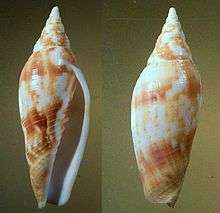Pleioptygma
| Pleioptygma | |
|---|---|
 | |
| Two views of a shell of Pleioptygma helenae | |
| Scientific classification | |
| Kingdom: | Animalia |
| Phylum: | Mollusca |
| Class: | Gastropoda |
| (unranked): | clade Caenogastropoda clade Hypsogastropoda clade Neogastropoda |
| Superfamily: | Muricoidea |
| Family: | Pleioptygmatidae J. F. Quinn, 1989[1] |
| Genus: | Pleioptygma |
Pleioptygma is a genus of large sea snails, marine gastropod mollusks in the superfamily Muricoidea.
Pleioptygma is the type genus of the family Pleioptygmatidae[3] and it is the sole genus in the family Pleioptygmatidae.[1][4]
Etymology
The generic name Pleioptygma is composed from the Greek word "pleios", which means "full" and from the Greek word "ptygma", which means "fold".[1] This is a reference to the numerous folds on the columella of the shell.
Description
In the genus Pleioptygma, the shell is medium to large in size.[1] The shell has mainly spiral sculpture.[1]
The type description of the genus Pleioptygma by Timothy Abbott Conrad (1863)[2] reads as follows:
| “ |
Subfusiform; aperture long; columella with very oblique plaits, numerous, alternated in size, or irregular, the largest being the second one from above. |
” |
Although the shell of these gastropods looks similar to that of mitrids (family Mitridae), they are unrelated enough to require their own family.
The family Pleioptygmatidae has been defined based on the anatomy of the only extant species Pleioptygma helenae: The foot is relatively large in comparion to the size of the shell.[1] Also the snout is relatively large.[1] The foregut (of the digestive system) is different from other families within the Muricoidea.[1] The proboscis is introvert, with a proboscis bulb that has an extreme thick wall.[1] The proboscis bulb is connected directly to the buccal mass.[1] There is no epiproboscis.[1]
Species
Species within the genus Pleioptygma include:
- † Pleioptygma brandyceae Petuch, 1994 - photo of the holotype
- † Pleioptygma carolinense (Conrad, 1840) - type species,[1] from Pliocene.[1] The type species is extinct.[3]
- † Pleioptygma debrae Petuch, 1994 - photo of the holotype
- † Pleioptygma heilprini Cossmann, 1899
- Pleioptygma helenae (Radwin & Bibbey, 1972)[5] - It is the only known living species in this genus.[1]
- † Pleioptygma kissimmeensis Petuch, 1994 - photo of the holotype
- † Pleioptygma limonensis Olsson, 1922
- † Pleioptygma lindae Petuch, 1991
- † Pleioptygma lineolatum lineolatum (Helprin, 1887)[1]
- † Pleioptygma lineolatum saginatum (Tucker & Wilson, 1933)[1]
- † Pleioptygma nancyae Petuch, 1994 - photo of the holotype
- † Pleioptygma prodroma (Gardner, 1937)[1]
- † Pleioptygma ronaldsmithi Petuch, 1994 - photo of the holotype
- † Pleioptygma swainsonii Broderip, 1836
- † Pleioptygma zaca Strong et al., 1933
References
This article incorporate public domain text from the reference [2]
- 1 2 3 4 5 6 7 8 9 10 11 12 13 14 15 16 17 18 Quinn J. F. Jr. (1989). "Pleioptygmatidae, a new family of mitriform gastropods (Prosobranchia: Neogastropoda)". The Nautilus 103(1): 13-19.
- 1 2 3 Conrad T. A. (1863). "Catalogue of the Miocene shells of the Atlantic slope". Proceedings of the Academy of Natural Sciences of Philadelphia 1862 14(10-12): 559-583. page 563.
- 1 2 Bouchet, Philippe; Rocroi, Jean-Pierre; Frýda, Jiri; Hausdorf, Bernard; Ponder, Winston; Valdés, Ángel & Warén, Anders (2005). "Classification and nomenclator of gastropod families". Malacologia. Hackenheim, Germany: ConchBooks. 47 (1–2): 1–397. ISBN 3-925919-72-4. ISSN 0076-2997.
- ↑ (in Czech) de Bruyne R. H. (2004). Encyklopedie ulit a lastur. Rebo Productions, 336 pp., ISBN 80-7234-288-6, page 191.
- ↑ Pleioptygma helenae (Radwin & Bibbey, 1972). Retrieved through: World Register of Marine Species on 24 April 2010.
External links
| Wikimedia Commons has media related to Pleioptygmatidae. |